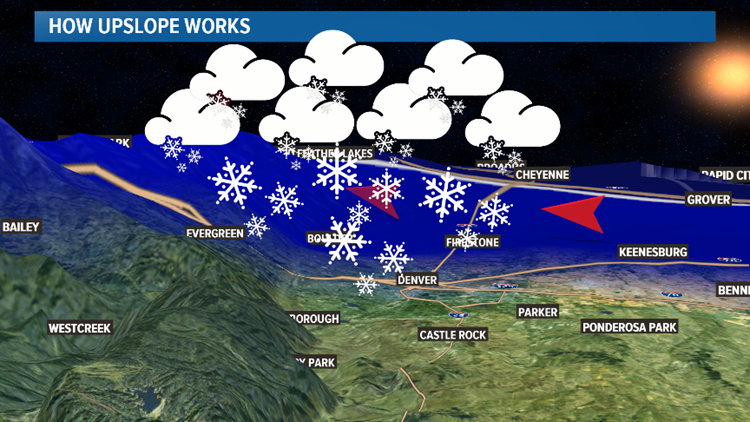

Not expecting flooding/debris flows in any bur scars.Travel on mountain and foothills highways is to be avoided if possible, including on Interstate 70 west of Denver.Snowfall rates of about 2 inches per hour possible.Snowfall totals of 1 to 2 feet expected above 8,000 feet with locally higher amounts.Front Range mountains, including areas just west of Fort Collins, including Rocky Mountain National Park and Cameron Peak, extending south of Colorado Springs.Winter storm warning for northern mountains and foothills During those same hours, the Denver metro area is looking at heavier showers with lighter showers persisting over a larger area into the evening and night time.Tuesday with another lighter, more scattered push later in the evening. Fort Collins area is expected to see heaviest showers roughly 4-7 p.m.Just before noon Tuesday, the weather service in Boulder sent on its Twitter account a radar loop from Tuesday morning through early Wednesday morning. Latest radar loop gives a better picture of where and when heaviest rain will fall Here are forecast updates as of Tuesday morning, including a winter storm warning, travel impacts and updated snowfall and rainfall forecasts for Fort Collins and other areas of the state, according to the National Weather Service. That is reflected in the snowfall and rainfall totals below from Monday's forecast. The storm track has shifted south, which increases the snow and rain totals of Denver south and decreases those predictions north and east of Denver. There are a few changes in the forecast as the slow-moving spring storm moves into Colorado on Tuesday and continues into Wednesday. We also have seen some 8 to 10' totals north of Denver (Westminster area), with generally 5 - 8' across Denver. Get more Colorado news by signing up for our Mile High Roundup email newsletter.Watch Video: Winter car emergency kit: What you need to include The greatest total we've seen this morning comes from Jefferson, with a total of 16.0' of snow The southeast metro area did quite well as well, with quite a few reports of 8 to 12' of wet heavy snow reported there. That flooding risk could be especially pronounced in areas already scorched by wildfires, he added.

“We’ve kind of forgotten the kinds of floods we can get in the Front Range,” Schumacher said. More realistically for the short term, Schumacher said the Front Range could see more widespread flooding, a far cry from the drought to which Colorado has become accustomed in recent years. “We know how quickly things can turn around here,” he said. The state appears headed into an El Niño weather pattern over the summer, which should mean a relatively wet summer.īut the added fuels could add to wildfire risk next summer as well, Schumacher noted. The state – and the rest of the Colorado River Basin – still suffers from warming and drying trends, so new plants and foliage this year could just as easily dry out, adding to the amount of possible fuel for wildfires that might spark in the future.Ī drying trend doesn’t appear to be an imminent risk, Russ Schumacher, director of the Colorado Climate Center, said. This year’s moisture that should keep major wildfires at bay also means a strong growing season across Colorado. While that’s good news for this year, it could also amount to a “double-edged sword,” Bollinger noted. At her own home, Bollinger said she noted 10 days in a row with measurable precipitation.ĬU Denver students create eco-friendly buildings for scientists in Antarcticaīollinger said wildfire risk heading into the summer is far lower now and the state should have enough moisture to stave off the worst wildfire risk.

Not only are the state’s dry soils – parched by years of drought – recharging but so too are reservoirs all around Colorado, Bollinger said. And this year especially, the moisture is welcome. May is generally Colorado’s wettest month, Becky Bollinger of Colorado State University’s Colorado Climate Center, said. Some areas in northwest Colorado saw an inch or two less rain than they typically receive, though, he said. Some areas saw between 3 to 5 inches more rain than usually falls, up to 200% of their normal precipitation. Much of the state’s eastern half has also enjoyed above-average rainfall, particularly along the Front Range and into the northeastern plains, Rodriguez said. This is also the wettest month in Colorado history. The top three wettest Mays in Denver are: And while more showers might be expected in the afternoon, not enough rain was likely to fall to nudge the city into any of the top three slots. Digital Replica Edition Home Page Close Menuįollowing repeated afternoon showers – and intermittent barrages of hail – Denver has logged its fourth wettest May on record, putting the precipitation in competition for one of the city’s wettest months in well over a century.Īs of Wednesday morning, Denver had recorded 5.52 inches of rain, according to National Weather Service Meteorologist Bruno Rodriguez.


 0 kommentar(er)
0 kommentar(er)
